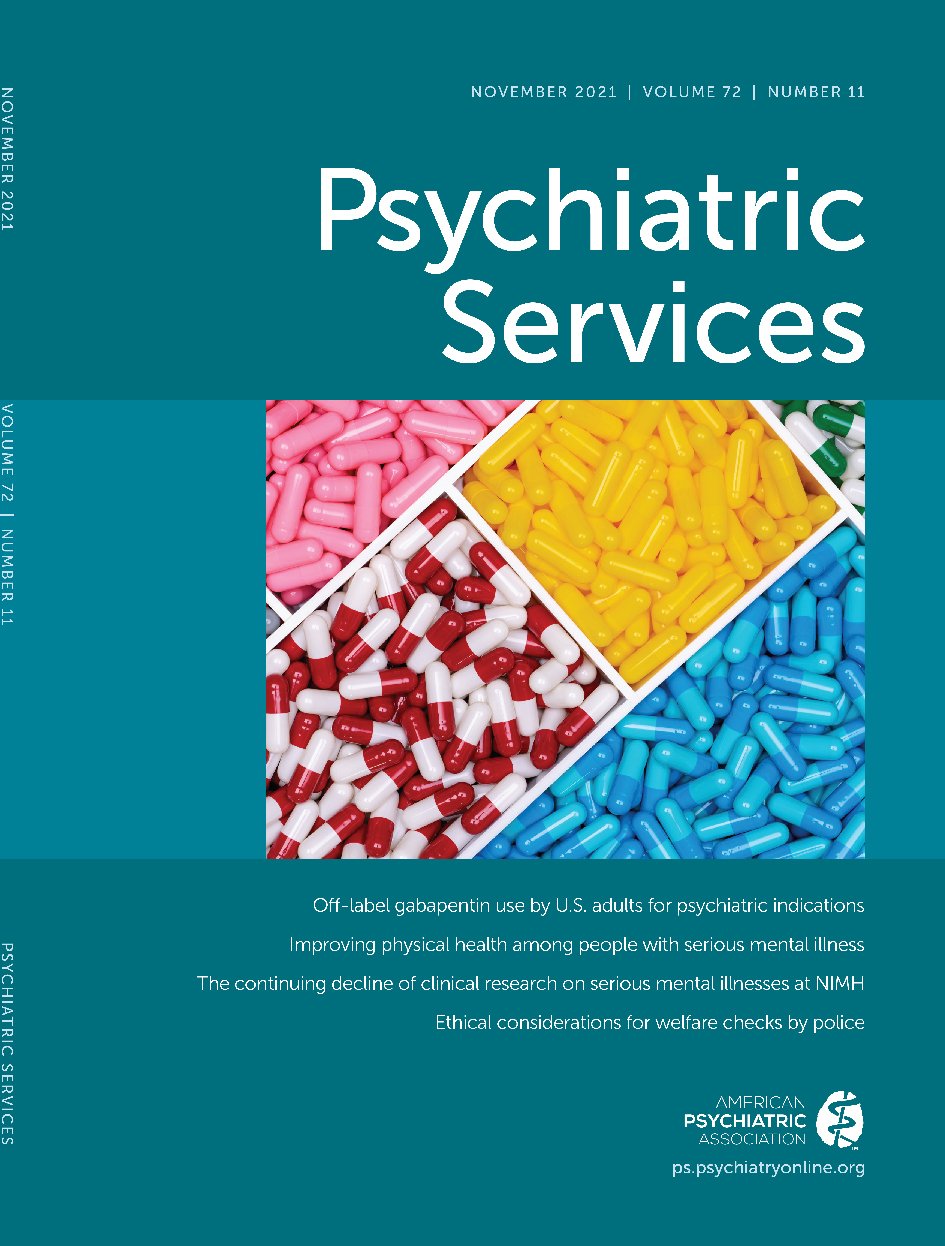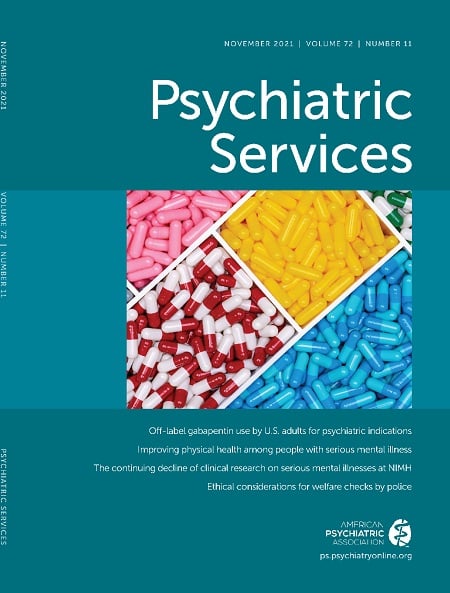Death by suicide is a major public health concern in the United States (
1). Individuals are at higher risk for suicide during care transitions, such as a discharge after a psychiatric hospitalization (
2). For example, a nationwide, case-control tudy of patients discharged after psychiatric admission found that 43% of suicides occurred within 1 month of discharge, and nearly 50% of these deaths happened before the first scheduled follow-up appointment (
3). Care transitions may pose a unique risk factor for suicide because of poor engagement, as well as disruptions in care (
4). These concerns may be especially relevant for patients who are more prone to isolation (
5), highlighting a critical need to develop focused interventions that address treatment engagement and social connectedness.
Several interventions have been developed to address suicide risk after psychiatric discharge (
6). Notably, three large trials of the World Health Organization (WHO) Brief Intervention and Contact (BIC) program found that the intervention helped prevent suicide among patients who were discharged after being treated for a suicide attempt (
6). Each of these trials was conducted in low- and middle-income countries with limited mental health resources (
6). More recently, the WHO BIC program has been modified for use in the United States, specifically for use in the Department of Veterans Affairs (VA) health care system. The VA BIC incorporates suggestions from clinicians and patients on modifications required for VA practice (
7), including alignment of the intervention with the existing and relatively high-resource VA suicide prevention program (
8) and the development of veteran-specific suicide risk education and resource materials. The VA BIC augments the VA suicide prevention program by targeting critical factors that may contribute to suicide risk during care transitions, including problems with treatment engagement and social connectedness (
7).
A feasibility and acceptability study of the VA BIC was previously conducted with nine patients being discharged from a VA inpatient mental health unit (
7). In that study, feasibility was measured by using enrollment success (70% of eligible patients enrolled) and retention (100% of enrolled patients remained in the study at 3 months). Acceptability was measured with the Client Satisfaction Questionnaire–8 (
9) at study completion, and patients perceived the VA BIC to be highly acceptable (
7).
We hypothesized that the VA BIC may reduce suicide risk after psychiatric hospitalization by decreasing suicidal ideation and hopelessness and by improving social connectedness and treatment engagement (
10). As a next step, we conducted a pilot randomized controlled trial (RCT) of the VA BIC. Our primary aim was to collect estimates of effect for suicidal ideation. Because there were no data from the original WHO BIC studies regarding hopelessness, social connectedness, and treatment engagement, our secondary aim was to calculate estimates of effects for these measures. On the basis of outcomes data from our previous acceptability and feasibility study (
7), we predicted that the VA BIC would have medium effects on measures at 1 and 3 months.
Methods
A detailed description of our methods is available as an
online supplement to this article. Briefly, we conducted a single-site, assessor-blinded, pilot RCT examining use of the VA BIC plus standard care versus standard care alone with adult patients admitted to an inpatient psychiatric unit because of acute risk for self-harm. As described in
Figure 1, the VA BIC aligns with the three-step theory of suicide (3ST), which proposes that there are three steps that put a patient at risk for suicide (
11). First, the person experiences pain (e.g., emotional or physical) and hopelessness. Second, the person experiences disruptions in social connectedness, including problems with thwarted belongingness and perceived burdensomeness. Third, the person has acquired, dispositional, or practical capacity to make a suicide attempt. Progression through the steps is accompanied by worsening suicidal ideation. The VA BIC may address the 3ST by improving engagement in treatment to reduce symptoms, increasing social connectedness, and educating patients about practical steps that they can take to reduce suicide risk (
7).
The study was conducted at the White River Junction VA Medical Center in Vermont between October 2019 and March 2020. Patients completed assessments at baseline and at 1- and 3-month follow-ups. The study was approved by the local institutional review board and was registered at ClinicalTrials.gov.
For our primary aim, we calculated effect sizes for suicidal ideation (with the Beck Scale for Suicidal Ideation) (
12) using Hedges’ g. Because suicide deaths (and attempts) are low-prevalence events, we could not generate reliable estimates in this small study. For our secondary aim, we calculated effect sizes for hopelessness (with the Beck Hopelessness Scale) (
13), social connectedness (with the Interpersonal Needs Questionnaire–15, which comprises thwarted belongingness and perceived burdensomeness subscales) (
14), and treatment engagement health care utilization data.
Results
Among 21 eligible patients, 19 (90%) patients consented to participation. There were no significant differences between groups at baseline. Patients who were assigned to the VA BIC completed all VA BIC follow-up contacts.
At 1 month, the VA BIC had a medium effect on suicidal ideation (Hedges’ g=0.45) and a large effect on thwarted belongingness (g=1.23, p<0.05) but a small effect on hopelessness and perceived burdensomeness (g=0.2). At 3 months, the effect remained for thwarted belongingness (g=0.81) but diminished or disappeared completely for other measures.
Finally, the VA BIC had a medium effect on treatment engagement, as measured by the number of non-VA BIC mental health visits (g=0.53). The first VA BIC contact usually occurred several days before the first non-VA BIC contact.
Discussion
Even within the context of a well-resourced mental health care system focused on suicide prevention, the VA BIC program may further reduce suicidal ideation and improve other measures associated with suicide risk. It appears that the greatest benefits of the VA BIC may occur within the first month after discharge. The VA BIC’s impact on thwarted belongingness may be a critical factor in its potential role as a suicide prevention strategy. A definitive trial of the VA BIC is required to confirm these preliminary results.
Because the adaptation of the VA BIC is novel, it is difficult to directly compare our findings with those of other studies. The original WHO BIC trials did not evaluate the mechanism by which the WHO BIC prevents suicide (
6). Moreover, unlike the original intervention, the VA BIC provides support to patients for 3 months after discharge (versus 18 months) (
6,
7). To make the VA BIC scalable and feasible to implement, it is important that the intervention be brief. Therefore, the intervention focuses on the period of highest risk, with most intervention contacts occurring within the first month. In this pilot, we also found that the effect of the VA BIC was greatest in the first month after mental health discharge. This could make the VA BIC more attractive, because a large proportion of suicides occur within the first 2–4 weeks postdischarge (
2,
3). However, because the effects of the VA BIC were less pronounced and potentially absent at 3 months, the design of the intervention may need to be enhanced by including additional follow-up contacts in the later months.
The VA BIC appears to have a particularly positive impact on social connectedness, primarily through improvements in thwarted belongingness. This is not surprising. As described in Joiner’s interpersonal theory of suicide, thwarted belongingness is a multidimensional construct that assesses perceived sense of inclusion (
14). The theory assumes that each person has a fundamental need to connect and that disrupted connectedness will have adverse consequences that contribute to suicide risk (
14). Because the VA BIC includes ongoing professional support and emphasizes social connectedness as part of the education, patients exposed to the VA BIC may not only feel more supported but also take more steps to connect with others. This finding is important because there is growing evidence that social isolation is a key factor that contributes to suicide risk (
5). It is conceivable that further enhancing the VA BIC with other strategies to enhance social connectedness (e.g., mobile health technology) could capitalize on the existing strengths of the VA BIC.
There were limitations to our findings. This study was designed as a small pilot RCT, and our findings may be spurious. The study was performed with U.S. veterans receiving care in the VA health care system. Few women were in the sample, and all female participants were assigned to the VA BIC. Most patients had multiple comorbid mental health conditions, were White, and lived in New England. Thus, it is unclear whether the study conducted in this rather specific population would generalize to other groups. Finally, compared with civilian settings, the VA health care system is highly resourced with regard to mental health treatment. In fact, regardless of study assignment, more than 60% of patients received any mental health follow-up within 7 days of discharge, and 100% received any mental health follow-up within 30 days of discharge. In comparison, in 2018, the proportion of U.S. Medicare health maintenance organization participants who received any mental health follow-up within 7 days or 30 days of discharge for treatment of mental illness (or intentional self-harm) was considerably lower (28% and 48%, respectively) (
15). Therefore, when looking beyond the VA and considering the potential relevance of the VA BIC to other hospital systems, it may be important to consider current standard care practices. Although the number of mental health contacts observed in our study may be unrealistic, the VA BIC may nevertheless have a notable impact on clinical outcomes. For example, if a hospital has no standardized mental health discharge care process, the VA BIC could have a greater effect in improving practice. Conversely, if a hospital already provides adequate mental health discharge care, the VA BIC may help, but perhaps to a lesser degree.
It is important to emphasize that, although the VA BIC was adapted from the WHO BIC, an intervention that has shown clear promise in preventing death by suicide in low- and middle-income countries (
6), the VA BIC differs from the WHO BIC in that it targets a broader inpatient population at risk for suicide. This difference may increase generalizability but may diminish the strength of the effect. In this small study, we also used suicidal ideation as the primary outcome (rather than attempts or death). Although we noted improvements in several measures, it is difficult to know whether these improvements translate into a reduction in suicide deaths. Suicide remains challenging to study in an RCT. It is critical to identify the mechanisms that contribute to suicide so that we can discover proximal measures that are objective, measurable, and responsive to change.
Conclusions
The VA BIC may improve symptoms of suicidal ideation as well as associated measures of suicide risk in patients after a psychiatric hospitalization. The greatest benefit of the VA BIC may be observed within the first month after hospital discharge. It will be important to conduct an adequately powered study of the VA BIC in a more diverse patient population to establish the efficacy of the VA BIC as a suicide prevention strategy.


